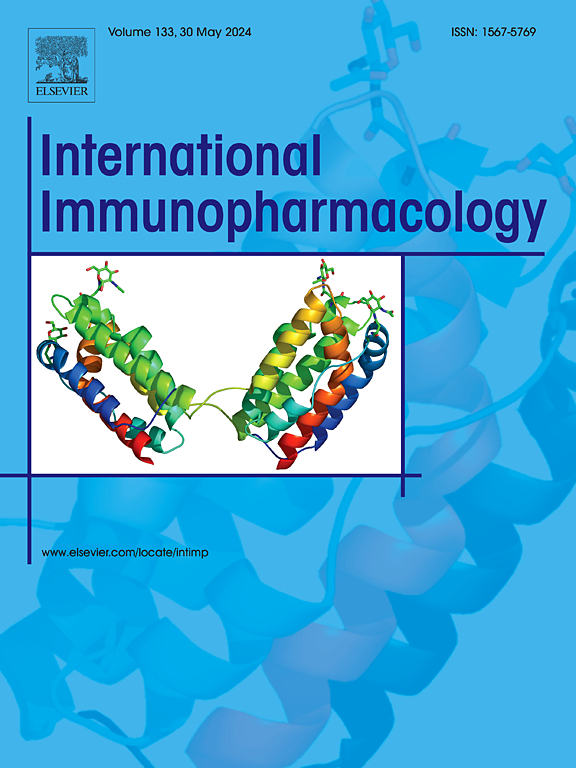6-Gingerol overcomes TMZ resistance in GBM by suppressing EMT and cell migration via the PI3K/Akt/β-catenin/c-Myc pathway
IF 4.8
2区 医学
Q2 IMMUNOLOGY
引用次数: 0
Abstract
Glioblastoma multiforme (GBM) is the most aggressive and treatment-resistant primary brain tumor with acquired resistance to temozolomide (TMZ) posing a major clinical challenge. This study investigates the therapeutic potential of 6-gingerol, a bioactive compound from ginger, in overcoming TMZ resistance in GBM and delineates its molecular mechanisms. TMZ-resistant GBM cell lines (U87-TR and A172-TR) were established which exhibited enhanced migratory capacity and pronounced epithelial-mesenchymal transition (EMT) features. Treatment with 6-gingerol significantly reduced cell viability, colony formation, and migratory ability, as demonstrated by wound healing and transwell assays. Co-treatment with TMZ and 6-gingerol restored TMZ sensitivity and enhanced cytotoxicity in resistant cells. Mechanistically, 6-gingerol suppressed matrix metalloproteinases (MMP-2 and MMP-9) and reversed EMT, as indicated by the upregulation of epithelial markers and downregulation of mesenchymal markers. Western blot and transcriptomic analyses revealed activation of the PI3K/Akt/GSK-3β pathway and overexpression of β-catenin and c-Myc in TMZ-resistant cells. 6-Gingerol inhibited PI3K/Akt phosphorylation and downstream targets, notably reducing c-Myc levels. Pharmacological intervention confirmed that PI3K/Akt signaling governs c-Myc expression and EMT progression in TMZ-resistant GBM. In vivo, 6-gingerol markedly suppressed tumor growth in a TMZ-resistant xenograft model without observable toxicity, accompanied by inhibition of the PI3K/Akt/β-catenin/c-Myc axis. These findings demonstrate that 6-gingerol effectively reverses TMZ resistance and EMT-driven invasiveness, supporting its potential as a novel adjuvant strategy in GBM therapy.
6-姜辣素通过PI3K/Akt/β-catenin/c-Myc通路抑制EMT和细胞迁移,克服GBM的TMZ抗性
多形性胶质母细胞瘤(GBM)是最具侵袭性和治疗耐药性的原发性脑肿瘤,对替莫唑胺(TMZ)具有获得性耐药性,对临床构成重大挑战。本研究探讨了生姜生物活性化合物6-姜辣素(6-gingerol)在克服GBM中TMZ耐药性方面的治疗潜力,并阐述了其分子机制。建立了抗tmz的GBM细胞株U87-TR和A172-TR,它们具有增强的迁移能力和明显的上皮-间质转化(EMT)特征。伤口愈合和transwell实验证明,6-姜辣素显著降低了细胞活力、菌落形成和迁移能力。TMZ和6-姜辣素共同处理恢复了TMZ的敏感性,增强了耐药细胞的细胞毒性。从机制上看,6-姜辣素抑制基质金属蛋白酶(MMP-2和MMP-9)并逆转EMT,这可以通过上调上皮标记物和下调间质标记物来证明。Western blot和转录组学分析显示,tmz耐药细胞中PI3K/Akt/GSK-3β通路激活,β-catenin和c-Myc过表达。6-姜辣素抑制PI3K/Akt磷酸化和下游靶点,显著降低c-Myc水平。药理干预证实,PI3K/Akt信号调控tmz耐药GBM中c-Myc的表达和EMT的进展。在体内,6-姜辣素显著抑制tmz耐药异种移植物模型的肿瘤生长,无明显毒性,同时抑制PI3K/Akt/β-catenin/c-Myc轴。这些发现表明,6-姜辣素能有效逆转TMZ耐药和emt驱动的侵袭性,支持其作为GBM治疗新辅助策略的潜力。
本文章由计算机程序翻译,如有差异,请以英文原文为准。
求助全文
约1分钟内获得全文
求助全文
来源期刊
CiteScore
8.40
自引率
3.60%
发文量
935
审稿时长
53 days
期刊介绍:
International Immunopharmacology is the primary vehicle for the publication of original research papers pertinent to the overlapping areas of immunology, pharmacology, cytokine biology, immunotherapy, immunopathology and immunotoxicology. Review articles that encompass these subjects are also welcome.
The subject material appropriate for submission includes:
• Clinical studies employing immunotherapy of any type including the use of: bacterial and chemical agents; thymic hormones, interferon, lymphokines, etc., in transplantation and diseases such as cancer, immunodeficiency, chronic infection and allergic, inflammatory or autoimmune disorders.
• Studies on the mechanisms of action of these agents for specific parameters of immune competence as well as the overall clinical state.
• Pre-clinical animal studies and in vitro studies on mechanisms of action with immunopotentiators, immunomodulators, immunoadjuvants and other pharmacological agents active on cells participating in immune or allergic responses.
• Pharmacological compounds, microbial products and toxicological agents that affect the lymphoid system, and their mechanisms of action.
• Agents that activate genes or modify transcription and translation within the immune response.
• Substances activated, generated, or released through immunologic or related pathways that are pharmacologically active.
• Production, function and regulation of cytokines and their receptors.
• Classical pharmacological studies on the effects of chemokines and bioactive factors released during immunological reactions.

 求助内容:
求助内容: 应助结果提醒方式:
应助结果提醒方式:


